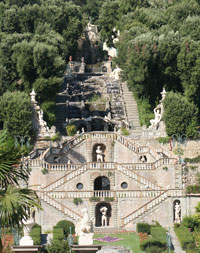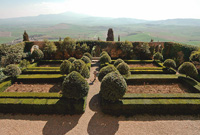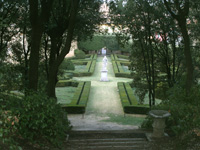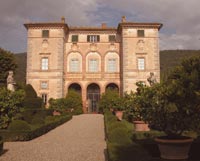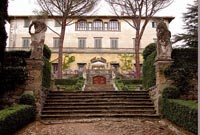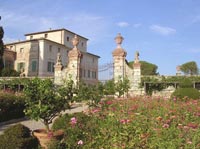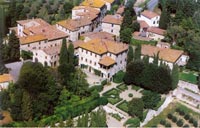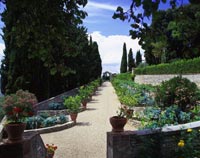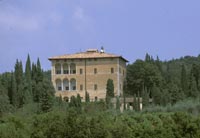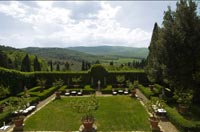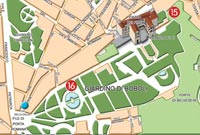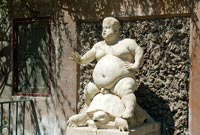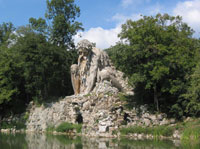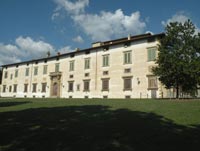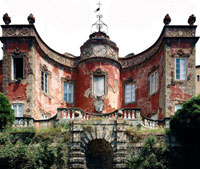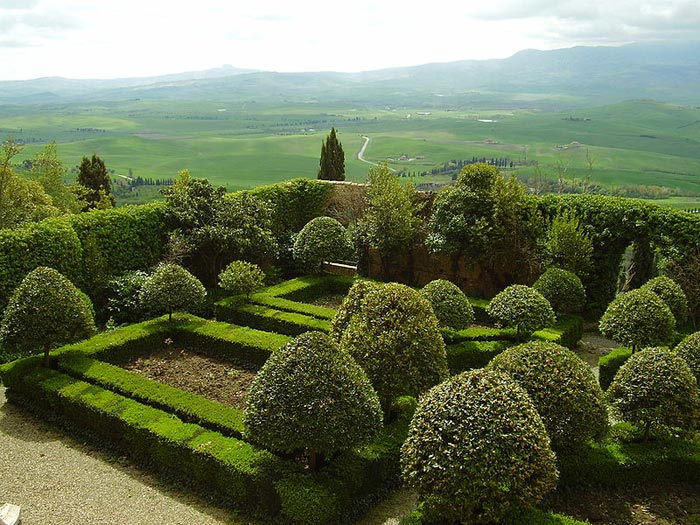 |
Giardino Piccolomini | Palazzo Piccolomini Garden in Pienza |
Gardens in Tuscany |
Gardens and villas, gardens and landscapes are inseparable concepts in Tuscany where the farm ends at the garden and the garden is the cradle of the villa. In Tuscany the relationship between human endeavor and the land itself is the result of a loving understanding that left a series of imprints that today seem almost poetic.The scenery and landscapes are part of the world heritage. They have been painted, drawn and photographed by famous as well as unknown people.And they have always been experienced in a setting that has the ancient knowledge of those who have lived through many centuries and civilizations. The origins are scattered through the remnants of Villanovian villages,of Neolithic finds,of the still mysterious splendor of Etruscan settlements and burial grounds,and in the wisdom and grandeur of Ancient Rome.They reveal a Tuscany scarred by the invasions of northern peoples who subdued but also enriched the land during the Middle Ages so that it could triumph in the splendors of Humanism and the Renaissance. Each era left visible marks on the land that reveal centuries of ever-changing artistic and cultural forms that have continued to develop up through the present. [Prof.arch.Mariella Zoppi] |
||
| Castello is the villa that Nicolò Tribolo built for Cosimo I, and more than any other embodies the rules set forth by Leon Battista Alberti. The garden, enclosed by walls is arranged on three terraces around a central axis of symmetry. The lunette by Utens shows a grove of cypress and laurel surrounding the statue of Hercules and Antaeus in line with the entrance to the grotto created between the second and third terraces. The grotto,decorated by Giambologna with animals carved in polychrome marble is the first example of Mannerist art in Medici gardens.If Mannerism made its debut in the grotto at Castello,it was Bernardo Buontalenti who brought about its triumph at Pratolino. Boboli is the Medici family’s celebrative garden.It was not meant to be merely a place of tranquility and repose,but a theatrically arranged park to meet the needs of the entire princely court.The first design was by Tribolo who organized the hill behind the palace into a huge terraced amphitheater on a single perspective axis. The sixteenth century arrangement on the left side of the palace gives us a fine little building begun by Vasari to house Michelangelo’s Slaves and it was continued by Bernardo Buontalenti with the splendid grotto with its three connecting chambers. During the following century the garden was expanded southward by Giulio and Alfonso Parigi around a second axis known as the Viottolone that steeply connects the area of the amphitheater with the splendid Vasca dell’Isola where the Ocean fountain by Giambologna stands majestically. |
||
| The Italian Renaissance garden was a new style of garden which emerged in the late fifteenth century at villas in Rome and Florence, inspired by classical ideals of order and beauty, and intended for the pleasure of the view of the garden and the landscape beyond, for contemplation, and for the enjoyment of the sights, sounds and smells of the garden itself. In the late Renaissance, the gardens became larger, grander and more symmetrical, and were filled with fountains, statues, grottoes, water organs and other features designed to delight their owners and amuse and impress visitors. The style was imitated throughout Europe, influencing the gardens of the French Renaissance and the English garden. |
||
|
||
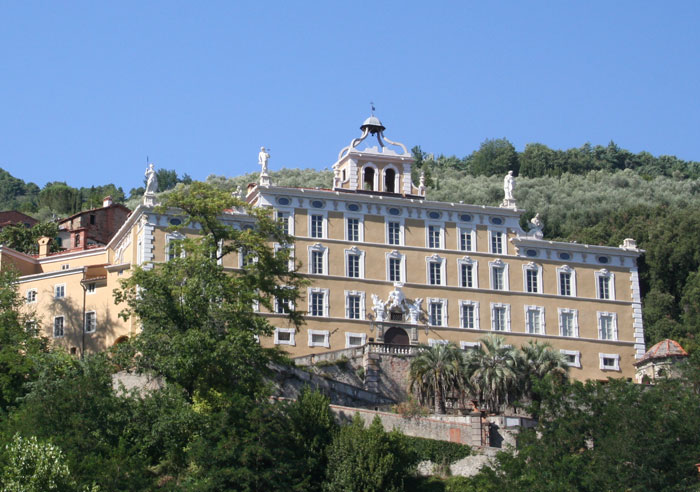 |
||
The Garzoni Villa in Collodi |
||
| During the XVII century Mannerism became the most diffuse style in Europe, and it was followed by a new type of garden, known as French style. The great protagonist of this new trend was André le Nôtre who constructed grandiose settings celebrating the splendor of a century of a single king, Louis XIV, the Sun King.T he French style arrived in Tuscany near Lucca, an area that had many business contacts with France and managed to maintain its political independence from the Medici Grand Duchy. The villas around Lucca comprised a settlement linked both to the city and hence its trade because they were the homes of the merchants, and to the countryside since they were on farming estates. They were places of investments in production, but also homes so their owners wanted them to be beautiful and increasingly pleasurable and prestigious. The French influence is even evident in the place names, Marilla became Marlia in honor of Marly, and in the choice of architects such as Filippo Juvarra who most certainly worked at Villa Mansi, and the legendary Le Nôtre who, it seems, drew up the plans for the gardens of Villa Torrigiani. Not far from the Lucca villas is the most beautiful example of a baroque garden in Tuscany, Villa Garzoni at Collodi. The park which is separate and distinct from the villa that dominates from on high, was begun in the mid 1600s and was completed a century later by Ottaviano Diodati with statues, plants of all species and countless fountains. Gardens in Tuscany | The historic Garzoni Garden and other gardens around Pistoia |
||
Siena |
||
| The villas in the area of Lucca, known as Lucchesia, contrast with those around Siena where the greatest blossoming occurred in the XVII century. From the formal standpoint there was a close link to the Roman experience both in spatial and cultural concepts as if to affirm its independence and distinct identity with respect to the Florentine domination. Many architects came from the baroque splendor of papal Rome, such as Carlo Maderno who designed the Cetinale garden where areas merge together in a series that goes from the geometric citrus garden behind the villa and continues along a long straight path starting from an exedra at the side of the entrance gate. But the marvels of this garden are in the Tebaide conceived as a mystical place dotted with statues of animals, penitents and tabernacles. No less interesting are the terraced gardens of Villa Chigi at Vicobello and the Celsa, Geggiano or Catignano villas. |
||
| Palazzo Piccolomini Garden in Pienza |
|||
| This is a small hanging garden which forms an integral part of the Palazzo and indeed of the entire town of Pienza, a small renaissance jewel in central Tuscany. The garden has logias on three sides and a splendid view from the fourth side, seen through an arched wall. Designed in the second half of the 15th century together with the papal palace, of which it is an integral part, this garden was commissioned by Pope Pius II (Enea Silvio Piccolomini) to Bernardo Rossellino. The small terraced area dominates the entire Val d’Orcia, and despite recent alterations still displays the typical features of the Renaissance garden. Opening times - All year. Daily - except Mondays and public holidays, Summer: open 10am to 12.30 and 4pm to 7pm, Winter: open 10am to 12.30 and 3pm to 6pm. Palazzo Piccolomini Garden website | www.pienza.com/piccolomini_gardens Gardens in Tuscany | Palazzo Piccolomini Garden in Pienza |
|||
| Villa La Foce |
|||
| Villa La Foce is the main house on the property, consisting today of almost 1200 acres of farmland several farmhouses. It was originally built at the end of the 15th century as a wayside tavern, but soon became the center of an estate belonging to the great Hospital of Santa Maria della Scala in Siena. In 1924 it was purchased by Antonio and Iris Origo. The villa is built on three levels, following the lie of the land, and is surrounded by the now famous gardens created by Iris Origo and the English architect Cecil Pinsent, who worked earlier in Villa I Tatti. There are many cultural activities organized by and around La Foce, held mainly in the "Castelluccio", a medieval castle only 1 km away. Address - 61, Strada della Vittoria, Chianciano Terme, Sienna, Tuscany, Italy, 53042 Opening times - Wednesday afternoons www.lafoce.com Giardini in Toscana | Villa La Foce |
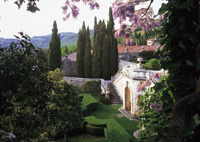 |
||
| Horti Leonini in San Quirico d'Orcia |
|||
| The Horti Leonini gardens are a splendid example of giardini all'italiana. They were designed in about 1540 by Diomede Leoni and periodically host temporary exhibits of contemporary sculpture. The Leonini gardens, or horti, which occupy a large public area in the ancient ramparts of San Quirico d'Orcia, were laid out around 1581 on a piece of land which Francesco I dei Medici donated to Diomede Leoni, hence the name. The gardens retain their original structure to this day, providing a well-preserved example of the traditional Italian-style. Gardens in Tuscany | Horti Leonini |
|||
| Cavriglia Rose Garden |
|||
A large scientifically organized rose garden in the hills of Tuscany. The garden is privately owned and funded by donations. |
|||
| Certosa di Pontignano |
|||
| The former monastery of Pontignano (now part of the University of Sienna) has three cloister gardens. Two are traditional grass rectangles and one is now a renaissance parterre garden. The monastery is set amongs olive groves, north of Siena. Address - Certosa di Pontignano, Pontignano, Vagliagli, Siena, Tuscany, Italy, 53010 Website - Visit the Certosa di Pontignano website | www.unisi.it Gardens in Tuscany | Monastery di Pontignano | 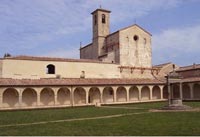 |
||
| Villa Capponi Garden |
|||
| The garden, commented upon by Edith Wharton and Geoffrey Jellicoe, dates from the seventeenth century. It was extended by Lady Elizabeth Scott after 1882 and by Charles Pinsent after 1939. Address - Pian dei Giullari, 4, Firenze, Tuscany, Italy Gardens in Tuscany | Villa Capponi |
|||
| Castello di Celsa |
|||
| The exclusive Castello di Celsa, owned by the princely Aldobrandini family, lies fourteen kilometers south-east of Siena. The old castle, converted to a palatial villa in the sixteenth century and with a garden built in the seventeenth century. The 16th-century garden, probably designed by the great Sienese architect Baldassare Peruzzi ( 1481 – 1537 ), has disappeared, overlaid by a formal parterre today displaying the Aldobrandini coat of arms in a box pattern, leaving only the elegant circular chapel as a record of the architect's work. Seventeenth-century designs for imposing gateways and a new pool mark the transition from fortress to villa. The Castello di Celsa is one of Italy’s best kept secrets and is open to the public. Address - 2 Castello di Celsa, Sovicille Gardens in Tuscany | Castello di Celsa Link Italian Gardens |
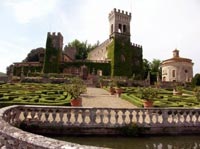 |
||
| Villa Cetinale |
|||
| Villa Cetinale is a 16th century villa in the Ancaiano district near Siena, Italy. Designed by the architect Carlo Fontana, the villa was built in the 1600s by Cardinal Flavio Chigi for Pope Alexander VII — Fabio Chigi. A restored and well-tended seventeenth century garden on a dramatic site. The Chigi family villa was designed by Carol Fontana in the seventeenth century and the garden was restored by Lord Lampton in the twentieth century. He also made an English flower garden below the villa. Steps ascend a hill into a sacred wood with statues of hermits. Gardens in Tuscany | Villa Cetinale Address - Villa Cetinale, 53098 Sovicille, Siena, Tuscany, Italy Garden visits are Monday to Friday 9.30 – 12.30 by appointment only. www.villacetinale.com
| |||
| Venzano Gardens |
|||
| An old Augustinian monastry, now the site of a nursery and a garden designed by an Australian. Address - Venzano, Mazzolla, Volterra (PI), Tuscany, Italy, 56048 www.venzanogardens.com |
|||
| Villa Chigi Saracini |
|||
| Villa Chigi Saracini near Castelnuovo Berardenga has been built up on the initiative of Count Galgano Saracini who wanted a great decorum house for his family, with a large park to make the most of it. Building the new complex produced a radical alteration of the main urban order, since a big part of castle-walls was been pulled down. The complex (villa-chapel-park) has been carried out between 1820 and 1840 and is partly attributed to Agostino Fantasici. The way the park now looks like is due to Count Guido Saracini, great music lover and founder of Chigiana Music Accademy. Count Galgano Saracini ordered the construction of the villa and park, which can be set between 1820 circa and 1840, and is in part attributed to architect Agostino Fantastici. Traversed by numerous lanes and paths, the park has a great variety of tree species and high-trunk trees, such as Atlantic cedars and holm-oaks and, by means of a Doric tepidarium of neoclassical inspiration, is connected to the "Italian" garden in front of the villa. In addition to the original layout of the park and garden, Fantastici also built the aforementioned tepidarium, the lake, tufa grotto and the carriageable bridge with three arches that connects the villa to the hill of San Quirico. The fountain was instead created by Tito Sarrocchi in 1866. Address: Castelnuovo Berardenga, Via delle Crete Senesi |
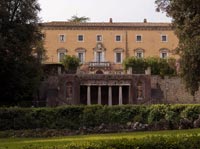 |
||
| Villa di Monaciano |
|||
| Villa di Monaciano, built from 1870 and 1885, by the noble Alessandro Pucci Sansedoni, coming from Siena but living in Florence. Following the spirit of renewal that reigned in Florence during that age, he built a completely innovating complex with villa and garden: moving the entrance road, pulling down the old walls that surrounded the garden and creating a lovely romantic park, in the wake of the parks designed by architects like Poggi in Florence. In terms of the architectural culture it expresses, the villa seems quite far removed from the Siennese tradition, having more in common with Florentine architecture of the second half of the 19 C. The building has three floors and the façade is divided into three parts by pilasters. The park is divided approximately into two parts: the first is a flower garden, the second, lower down, is a romantic park comprising extensive wooded areas crossed by winding paths along which unexpected views open up, with the villa providing the backdrop to the panorama. The landscaping of the garden is based on the English style where full green spaces alternate with empty open spaces, forests offset by clearings. The romantic park is made up of evergreen high-standing trees such as Holm oak trees, a large Lebanese Cedar, as well as horse chestnut, oak and palm trees. Gardens in Tuscany | Villa di Monaciano Address: Castelnuovo Berardenga, località: Ponte a Bozzone Open from April 1st until October 31th. |
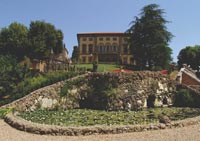 Villa di Monaciano |
||
| Villa di Catignano |
|||
| The Villa di Catignano was built at the end of XVII° century by Quinto Settano, pseudonym of Monsignor Lodovico Sergardi, a writer and a lover of the arts. The small borough already existed in 1500 with the name of "Clatinianum as a property of Sergardi family. Nowadays the Villa, overlooking a beautiful italian garden, decorated with statues representing the four season, and the medievaltowers of Siena in the distance, is divided into apartments, and is not open to the public. Gardens in Tuscany | Villa di Catignano |
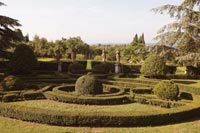 Villa di Catignano, garden |
||
Castello di Uzzano |
|||
| The Castello di Uzzano (Castle of Uzzano) is a fine Renaissance villa located on the outskirts of Greve in Chianti. The villa has a double-columned façade of white plaster and pietra serena. There are a few remains of the original rectangular mediaeval watch tower. Traces of the ancient castle may be discerned in the remains of a watch tower but the predominant form of the structure is now a large 17th century villa with an excellent italianate garden restored in the 18th century. |
|
||
| Villa Vicobello |
|||
| The 16th-century Villa Vicobello, near Siena, and its terraces, which descend steeply below the walled lemon garden, were designed bv Baldassare Peruzzi. On one side the large courtyard opens onto a park of ilexes, limes and horse-chestnuts known as the "English Wood" and extending over about 8,000 sq. m. To the south are the gardens which descend in terraces from the parterre adorned with huge vases of orange and lemon trees, with the various levels connected by artistic stone staircases from which we can admire the distinctive layout of the Italian garden (with flower beds bordered by box hedges). Inside the garden are fine sculptures representing the six mountains which feature on the Chigi coat-of-arms. (From the upper terrace, where there is an artistic fountain in the form of a half-moon, we can enjoy a splendid view of Siena, of the Torre del Mangia and the Duomo.) The trees, which include an imposing Ginkgo Biloba, although more recently planted, do nothing to detract from the character of the garden, on the contrary enhancing its atmospheric charm. Among the rooms in the interior are 3 large halls with high ceilings; one of these, particularly spacious and bright, also features six pillars and a sail-vaulted ceiling. Gardens in Tuscany | Villa Vicobello Viale R. Bianchi Bandinelli, 14 - 53100 Siena | 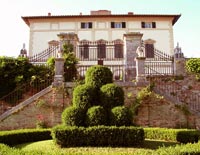 |
||
| Villa di Geggiano | Villa Bianchi Bandinelli |
|||
| Five kilometres from Siena near Castelnuovo Berardenga, on the top of a hill covered in vineyards, stands villa di Geggiano, belonging as of 1527 to the Bianchi Bandinelli family. Renovated between 1780 and 1790, it forms, together with the surrounding garden, a very unusual complex, both from the historical and the landscaping point of view. The Villa di Geggiano, owned by the Bianchi Bandinelli family from the first half of the 16 C, was originally a much smaller lodge, which in 1768, was transformed into a grand villa with a garden and its own chapel on the occasion of the wedding of Anton Domenico Bianchi Bandinelli and Cecilia Chigi. In the origin, the villa di Geggiano, which has belonged to the Bianchi Bandinelli family since 1527, was a cottage. In 1768, when Anton Domenico Bianchi Bandinelli married Cecilia Chigi, the building was transformed into a magnificent villa with a private chapel and a garden. Gardens in Tuscany | Villa di Geggiano |
|
||
| Castello di Fonterutoli |
|||
| Fonterutoli is located 5 km south of Castellina in Chianti (Siena), on the hills facing the Val d'Elsa. Owned by the Mazzei family since 1435, it still retains its original form, that of a tranquil country village: a cluster of houses, the church of San Miniato and the villa, built at the end of the 1500s where the medieval castle once stood. On the main square next to the ancient church is the family villa. Already known by the Etruscans and subsequently in Roman times as Fons Rutolae and Fons Rutilant, it was considered a stopping-off point where travellers between Florence and Siena could find refreshment. It was here, in 998, that Ottone III, Emperor of the Holy Roman Empire, issued an edict transferring the possessions of the church of Arezzo to the Siena Committee. Fonterutoli was again the site, in 1202 and 1208, of the signing of the peace treaties that determined the historic assignment of the Chianti region to the Republic of Florence. With regard to this, there is a popular legend saying that in the first years of the thirteenth century, the lords of Florence and Siena, exhausted by the endless wars over the Chianti region, agreed that the borders would be defined by a horse race: the riders would have started at the crowing of the cock, one from Florence and the other from Siena. The border would has been set at the place of their meeting. The Florentines chose a little black rooster, skinny and starved, who crowed constantly out of hunger. The morning of the race, this rooster crowed long before dawn, which permitted the Florentine rider to start out with a great advantage and to cover far more distance before meeting his opposite number, almost on the outskirts of Siena, at Fonterutoli, to be exact. Since then, the black rooster became emblem of Chianti and then of the wine produced in this area, famous throughout the world. It's symbol also of the consortium which represents most producers. The Castle of Fonterutoli is still owned by the Marquis Mazzei family, who settled since 1435. Its appearance has not changed during the centuries, preserving some buildings. Only the original Castle has been replaced by the villa at the end of the sixteenth century. Address: Fonterutoli 1, Castellina in Chianti | www.fonterutoli.it |
|
||
Casole d’Elsa |
|||
| Casole d’Elsa is a town located in the province of Siena, in the Northern Italian region of Tuscany. It is located on a hill overlooking the Elsa Valley, offering tourists breathtaking views of the surrounding Tuscan countryside. Besides the magnificent natural surroundings, you can enjoy the wealth of monuments found in Casole d’Elsa and the surrounding area. Visit the Collegiata, adorned with impressive frescoes and now the location of the Archeological Museum. Next, check out Villa La Suvera, a Renaissance papal villa transformed into a 5 star hotel with a museum on its first floor. Villa San Chimento, built in the 16th century, is also worth a visit. |
|||
| Pievescola | Relais La Suvera |
|||
| Relais La Suvera, a former medieval castle and Papal villa, stands high on a hill, overlooking rolling Tuscan countryside and Chianti vineyards. Set around a picturesque courtyard, the Renaissance villa, a 16th century church and converted farm buildings, the villa belongs to Marchese Ricci and his family. The origins of La Suvera go back to the High Middle Ages as the Castle of the County of Siena ruled by the legendary Countess Ava Matilde dé Franzesi, a relation of the King of France Clovis, also known as the Queen of Montemaggio. It is therefore likely that the ancient name La Suvera derives from the French souveraine, meaning sovereign. The villa today is the heart of a borgo which has developed over the centuries, with a consecrated church dedicated to Saint Carlo Borromeo in the 1400's with interiors that reflect 18th century tastes. A few later buildings complete the complex which is surrounded by a park with Italian formal gardens dating back to the 18th century. The first records of the building date back to 1138, when it was the property of the powerful Longobard family, the Ardengheschi. In the mid-16th century, Pope Julius II (Giuliano della Rovere) received the villa as a gift from Pandolfo Petrucci, lord of the Republic of Siena. The pope ordered that what was then an austere fortress be transformed into a splendid Renaissance villa, surrounded by a large park, and the famous Sienese architectect Baldassarre Peruzzi was commissioned to carry out the plan. After Niccolò della Rovere, nephew of Julius II, the villa became the property of the Chigi family of Siena then changed hands several times again and was eventually bought by the present owners, the Ricci marquises, who have now turned it into a five-star country hotel. The grounds have several interesting features: a large courtyard to the north, with a fine 18th-century ironwork aviary at its centre; an Italian-style garden adorned with potted lemon trees; and another garden to the south with a lily pool; a wood of holm-oaks crossed by winding paths is also part of the estate. Gardens in Tuscany | Villa La Suverana www.lasuvera.it | The garden is open for the public from April to October |
|
||
| Villa San Chimento |
|||
| Villa San Chimento, built in the late 16th century by the Accarigi family in località Scorgiano, is an imposing two-storey building with a fine portico at the centre of the main front, in front of which is a terrace which is reached by a broad polygonal flight of steps. Adjoining the building is an attractive Italian-style garden, set out with circular flower-beds edged with box hedges and crossed by a winding path. Inside the property is an ancient oil press that is still in use. | 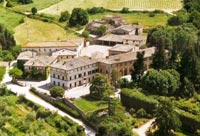 |
||
| Villa Simoneschi in Chianciano Terme |
|||
| Villa Simoneschi, an ancient private villa dating back to around 1830, is situated in the immediate vicinity of the historical centre of Chianciano Terme. The three-storey building, entered through a monumental gateway on Via Dante, stands at the centre of a fine garden filled with flowers: most notably rose bushes, but also some quite rare plants such as Hibiscus syriacus (known in English as "blue bird" or shrubby mallow), Lippia citriodora (lemon verbena), Osmanthus fragrans (fragrant, or tea olive), Ruscus hypoglossum (butcher's broom) and Paeonia officinalis (peony). From the entrance, a Neoclassical chapel is seen to the right, with a huge Lebanon cedar towering beside it like some monumental belltower; on the opposite side is a stone fountain with spring water.
At the end of the forecourt, towards Monte Cetona and the valley below, is an impressive panoramic terrace. | |||
| Parks and Gardens in Siena |
|||
| Siena is home to several parks and gardens. Established in 1784, Siena's Botanical Gardens cover a vast area and include greenhouses displaying tropical and aquatic plants. The Orto Botanico can be accessed in the centre of Siena, near to the Piazza Sant'Agostino. La Lizza is a public garden, situated by the Forte di Santa Barbara. Originally laid out in the 18th century and probably ed as a place to hold tournaments, La Lizza was transformed into a public garden in 1937. Located in the San Prospero district of Siena, and close to the Piazzo de Campo, is Siena's Park of Remembrance, which is known locally in Italian as the Parco delle Rimembranze. All the trees in this garden were planted in memory of fallen soldiers from World War One. Orto de'Pecci ia a cooperative garden with a fabulous view of the Torre del Mangia. Maintained as a cooperative, this small green space evokes the floral scents of the Tuscan countryside. Although not very easy to find as it's tucked away somewhat, the Orto de'Pecci garden is a great place to escape the busy city streets for a while. Gardens in Tuscany | Parks and Gardens in Siena |
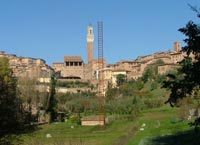 |
||
| Palazzo Passerini a Fontecumola (called Il Palazzone) in Cortona |
|||
| The impressive and princely villa Palazzo Passerini a Fontecumola (called Il Palazzone) was was owned by Silvio Passerini (1496-1529), a follower of the Medici family, and constructed in 1521 by architect G. Battista Caporali. The paintings of Luca Signorelli can be admired in the nobleman's chapel as well as frescoes by F. Bernabei, considered one of his most prestigious students. Bernabei, called the Papacello, frescoed the hall of honour with scenes of Roman history, among which should be noted the battle of Trasimeno, the death of Marco Curzio and the head of Hasdrubal thrown into Hannibal’s camp. Il Palazzone is located outside the massive ancient town walls of Cortona, and can be reached by a pleasant walk away from the center of Cortona (about 1,5 Km: you walk from Piazzale Garibaldi on Via Gino Severini and along the way you will find several tourist signs for reaching Il Palazzone). Count Lorenzo Passerini of Cortona was a descendent of Cardinal Silvio Passerini (1469-1529), Bishop of Cortona, who had the stately building constructed as evidence of the power obtained by his own noble family, which had remained loyal to the Medici dynasty. Passerini, protected when he was young by Lorenzo il Magnifico, and then by Giovanni, future Pope Leone X, was governor of Florence, ambassador of Perugia and tutor regent of the nephews of Clement VII. The construction of the villa was commissioned at the beginning of the 16 th century; the artist chosen was the architect and painter Giovanni Battista Caporali, pupil of Perugino. Gardens in Tuscany | Villa Palazzone |
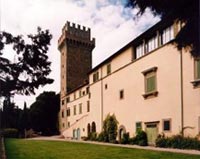 Villa Palazzone |
||
| Firenze |
|||
Italian art city par excellence, Florence is also a surprisingly green metropolis, home to numerous splendid gardens. Palazzo Pitti is a grand structure that now boasts no less than seven museums. Amongst these are the Medici treasures that are showcased in the Museo degli Argenti, the Museum of Costumes the Porcelain Museum and the Galleria d'Arte Moderna. |
|||
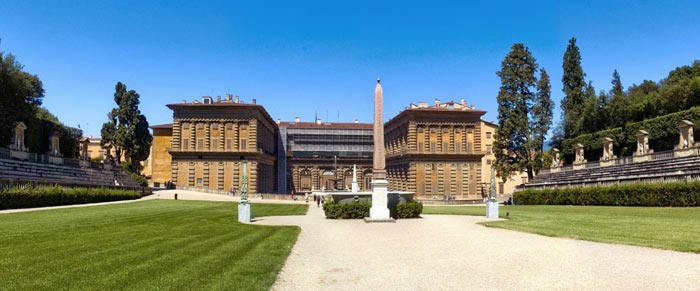 |
|||
Giardino di Boboli |
|||
Created and altered over four centuries, the Boboli Gardens in Florence represent layers of garden history. Begun in 1549 by Duke Cosimo I and his wife Eleonora of Toledo, after the acquisition of the Pitti Palace from the Pitti family. The initial stage of the garden was the work of Niccolò Tribolo, who had already designed the Villa Medici (Castello). Palazzo Pitti is a grand structure that now boasts no less than seven museums. Extending behind the palace are the elaborately landscaped and beautifully maintained Giardino Boboli (Boboli Gardens). The most celebrated aspects of the gardens include the Grotta del Buontalenti located close the entrance. In the deepest recess of the cave is Venus Emerging from her Bath attended by curious imps. Another notable structure is the enormous amphitheatre designed on a scale to serve the Medici's tastes. The Coffee House, Lemonary and the Lawn of Columns were later additions made on the request of the Lorraine family in the late 1700's. The Boboli Gardens were re-opened to the public in 1776 by Pietro Leopoldo and were to provide a source of inspiration for a number of European palace gardens including that of Versailles. Gardens in Tuscany | Boboli gardens |
|||
| Villa di Pratolino |
|||
| The Villa di Pratolino was a Renaissance patrician villa in Vaglia, 12 kms north of Floerence. It was mostly demolished in 1820: its remains are now part of Villa Demidoff. The large estate was purchased in 1568 by Francesco I dei Medici, who commissioned Buontalenti to build a splendid villa (1569-1581), for the use of Bianca Cappello. The surrounding park was imaginatively furnished with various delights, including monumental fountains. Most of these contraptions were designed by Buontalenti himself. The most noteworthy original work in the park, is a huge statue sculpted by Giambologna, the Colossus of the Apennines. Statues and water supply systems began to disappear from Pratolino in the 17th century, despite the fact that it was a cultural model imitated throughout Europe. The complex, which was too costly to maintain, fell into a period of decline under the Lorraine. Many of the statues were transferred to the Boboli gardens in Florence, and the park became a game reserve. Pratolino's seemingly inexorable decline was halted in 1819, when grand-duke Ferdinando III of Lorraine transformed the splendid garden from the Italian to the English style, with the help of the Bohemian engineer Joseph Frietsch. The park, which had been owned by Leopoldo II since 1837, was sold upon his death to Paolo Demidoff, who redeveloped the property, transforming the surviving paggeria building into a comfortable abode. Demidoff's last descendant bequeathed the property to Florence's provincial authorities. Although many works of art have been removed over the centuries, the park still contains much of great interest. Gardens in Tuscany | Villa di Pratolino |
|||
| Villa di Castello |
|||
The Medici Villas form a totally new system of residences built by the Medici family outside the walls of Florence, in the centre of vast farming properties. From the 15th to the early 18th century, the Medici family played a decisive political role in the Tuscan territory, adding to their city homes, more specifically connected with the exercise of their power, these places for recreation and hunting which, thanks to the Medici patronage, became meeting places for literati, philosophers, and artists. The group of villas was built during the phase of the family's political success, while the city of Florence was becoming the heart of the formation, and later the expansion throughout Europe, of the Renaissance culture. The villas were splendid residences, rich with works of art (Botticelli's "Spring" was painted for the villa in Castello), which were both excellent economic investments that were a source of constant income, and safe political centres, since they guaranteed the control of the territory of the Grand Duchy of Tuscany. Each member of the Medici family had his own estate as a place of pleasure and representation and, depending on the seasons, the Grand Duchy moved from one villa to another; for hunting at Pratolino and Cafaggiolo, and in the winter toward the sea in search of milder temperatures. |
|||
| Giardino di Villa Bardini |
|||
Giardino di Villa Bardini - Recently restored it is a very beautiful garden besides the Villa with the same name (which often organizes exhibitions), and not far from Fort Belvedere. The garden extends on a slope where you can enjoy a terrific view of Florence. In the garden you can see various kinds plants and flowers. The Garden is located behind Palazzo Mozzi, on the Montecuccoli hill, which belonged to the Mozzi family since 12th Century. The Baroque Stairs are the most striking decoration of the Bardini Garden; at its top is a wide terrace with a belvedere-loggia, from where we can enjoy a beautiful view on Florence. At the sides of the stairs are six fountains with mosaics and flowers. In the lower part of the garden is a small green theater, which was built on the side of the hill. Among the many decorations of the garden the two grottos are to be remembered: the smaller one, in the upper part of the garden, imitates a natural cave; the bigger one is more decorated and is very near to the rear of the palace Mozzi, which is now under restoration. Bardini Garden is not only decorated with statues and buildings, but also with countless flowers: their flourishing give to the whole garden a different face in each season. Gardens in Tuscany | The Bardini Garden in Florence |
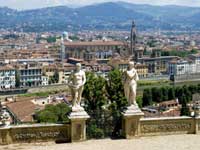 Statues in the Giardino Bardini |
||
Giardino di Villa Corsini - The large garden behind the “Palazzo Corsini al Prato” is another example of a garden with paths marked by hedges and statues. Also fragrant of lemon pots. The garden is open to the public only during certain events, particularly at auctions or charities during " Artigianato e Palazzo " a show that takes place each year, in May, the ancient artisans crafts are represented. It 'a good time to visit this beautiful garden. |
|||
Lucca |
|||
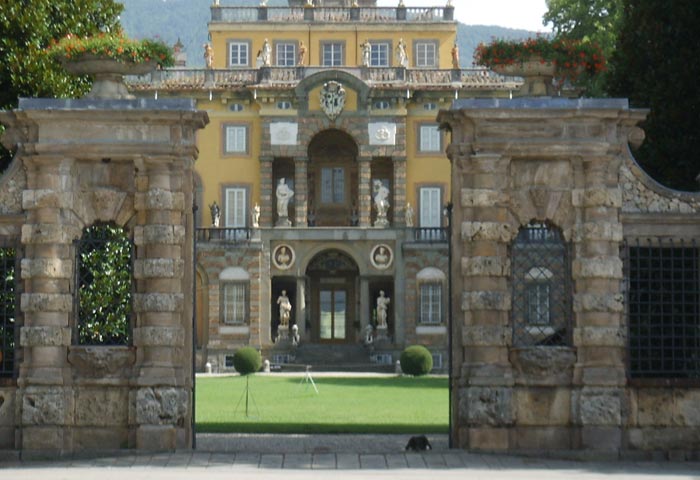 |
|||
Villa Torrigiani |
|||
| Lucca is renowned all over the world for its city walls, erected between 1504 and 1645. An important example of military architecture, the walls, which have never been used for defensive purposes, have been transformed into a charming promenade around the city. Lucca is called the hundred-church town because of its numerous buildings of worship, the most important being the Cathedral of San Martino, the church of San Giovanni and Santa Reparata, San Michele in Foro and San Frediano. The Sorroundings of Lucca boast an unique "Villas Landscape". The Villas, or rather the palaces in villa, are historical country residences that the Lucchesi merchants built between the 15th and 19th centuries, investing the fruits of their business and banking activities in central Europe. More than three hundred Villas, large and small, are spread out over the arc of hills that both defines and brings to a close the geographical bounds of the Plain of Lucca. Among them: Villa Reale di Marlia, Villa Grabau, Villa Bernardini, Villa Oliva, Villa Mansi and Villa Torrigiani in Camigliano. |
|||
| Palazzo Pfanner |
|||
Palazzo Pfanner has a beautiful garden, belonging to Filippo Juvarra (1678-1736), that faces the city walls.
|
|||
Garden of the Villa Reale di Marlia |
|||
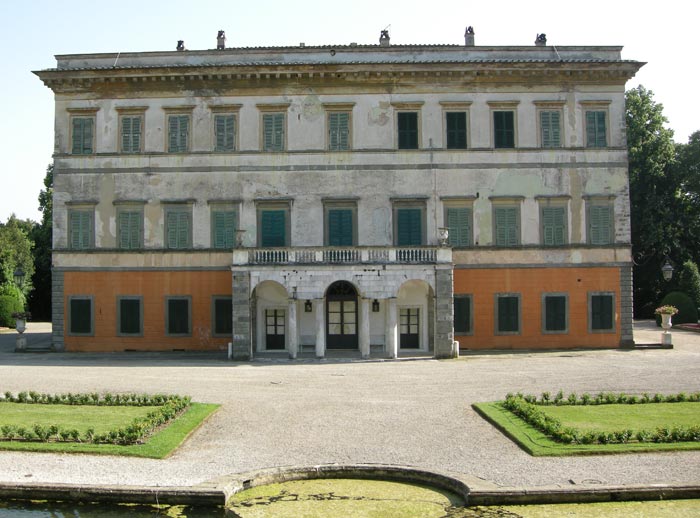 |
|||
Villa Reale di Marli a |
|||
Garden of the Villa Reale di Marlia | The Villa Marlia is an Italian Renaissance residence in the province of Lucca. It is famous for its water garden, especially the water theatre. Gardens in Tuscany | Villa Reale di Marlia and other gardens around Lucca |
|||
Villa Torrigiani |
|||
| Villa Torrigiani, which is one of the most opulent and spectacular in the whole Lucca area, dates back to the mid-16th century. The long and monumental avenue leading to the villa is lined with cypresses, and has a pompous gate from where the façade can be seen, so rich and adorned that it seems to be embroidered on the stone and marble in a triumph of niches, statues and balustrades. The original building dates back to 1500, but it was radically rearranged a century later by Maurizio Oddi, the same architect who had so deeply transformed Villa Mansi. The "garden of Flora" is the clearest example of Lucchese taste, an amusing and surprising ensemble of grottoes, nymph temples, flowers, masks, secret water games, all intended to make you feel as if you were in a fairy-tale.
Address Villa Torrigiani, Via del Gomberaio 3, 55100 Camigliano Santa Gemma |
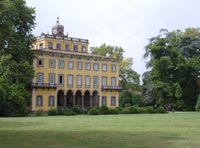 |
||
Villa Grabau |
|||
Only 7 kilometers from the city centre of Lucca,the Villa Grabau offers a lovely,romantic environment. The English Garden is a special example of botanical garden and keeps trees from all over the world. Located at the foot of the Colline Lucchesi, Villa Grabau is an outstanding example of neo-classical architecture, even if its origins are much more ancient. It was built during the first half of the 16th century, on a pre-existent medieval building, by the powerful Diodati family. During 1868 the villa was bought by the Grabau family, originating from Hamburg. They are still the owners of the property. Its nine hectare park, one of the most interesting in the Lucca area, is made up of a box hedge theatre, a large English Garden with its many rare species of tall trees, and a great Italian garden. Address Villa Grabau: Via di Matraia 269, 55010 San Pancrazio |
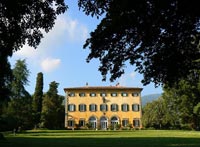 |
||
Villa Bernardini |
|||
| Villa Bernardini was built between 1600 and 1615 among the green hills of Gattaiola. The villa is surrounded by a wide park divided into three different areas. Together with the garden in front of the villa, which is called "Giardino degli innamorati" (Lovers` garden) due to its heart-like shape and is the result of 19th-century renovation works, there are a secret garden and a verdure theatre dating back to the 18th century. |
|||
Villa Oliva |
|||
Villa Oliva was built in the XVI century for Lodovico Buonvisi. A very famous sculptor and architect, Matteo Civitali, was commissioned to build it. The columns, of the so-called Matraia stone, are from a single block; the arches of the open gallery comprise the ground floor and the first floor, where the two living rooms are superimposed in the manner of the Lucchese villas. |
|||
|
|||
Villa Garzoni | In the past, situated in the Republic of Lucca, right on the border with the Grand Duchy of Tuscany, Villa Garzoni lies at the foot of the town of Collodi, almost as though it supported its weight. The first certain news of the villa built by marquis Romano Garzoni, dates to the first half of the 17th century. In the 18th century, architect Ottaviano Diodati from Lucca built the elegant little summer house and organised the garden. |
|||
The historic Garzoni Garden represents a felicitous synthesis between Renaissance geometry and the spectacular quality of the nascent Baroque. The garden rises from a semi-circular parterre, through terraced flights of steps to a water cascade, thrusting into the woods. The cascade widens as it ascends the hill, making it more dramatic when seen from below and more extensive when seen from above. The garden was built shortly before 1652[1] by the Garzoni family, relating to the site of the old castle, which stands slightly apart, closely associated with the village that nestles round it, on the edge of a clifflike slope, which had been chosen in earlier times for its defensible approach. The garden of Villa Garzoni, whose layout [2] "makes the fullest use of a precipitous hillside site in a manner that is usually associated with Rome", features a giochi d'aqua, or water garden, constructed at the foot of a series of balustraded terraces and a suite of grand symmetrical staircases connecting the lower water gardens at the base of the hill, with the house, the cascade, the teatro di verdura and other garden features above . At each terrace level, side walk past fantastically clipped yew blend imperceptibly with the wooded slope. Gardens in Tuscany | The historic Garzoni Garden and other gardens around Pistoia |
|||
| Arezzo |
|||
Palazzo Di Monte was built between 1515 and 1517 by Antonio da Sangallo the Elder for cardinal Antonio Di Monte. The facade is characterised by the pietra serena rustication of the ground floor and the classical-style windows of the first floor. The rear facade, done later on a project by Nanni di Baccio Bigio, faces a small hanging garden planted on a tank used to collect water. Today, the building is the headquarters of the municipality. Address: Monte San Savino, Corso Sangallo 38 |
|||
| Livorno |
|||
Palazzina dei Mulini, adjacent to Fort Stella, was one of the residences occupied by Napoleon Bonaparte and his court during his exile on the Island of Elba. Its name, "Mulini" derives from the previous existence of mills, later converted into houses. On the facade is a beautiful sundial from 1825. The villa contains paintings and mementoes of the Emperor as well as some furniture, mainly in Empire style. Address: Portoferraio, Piazzale Napoleone |
|||

